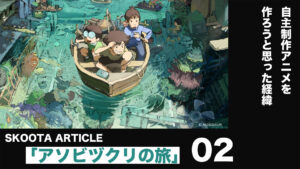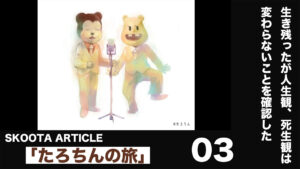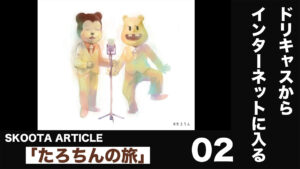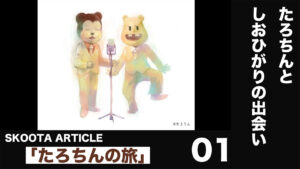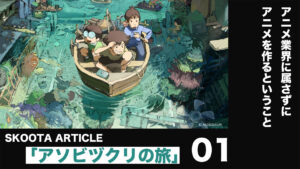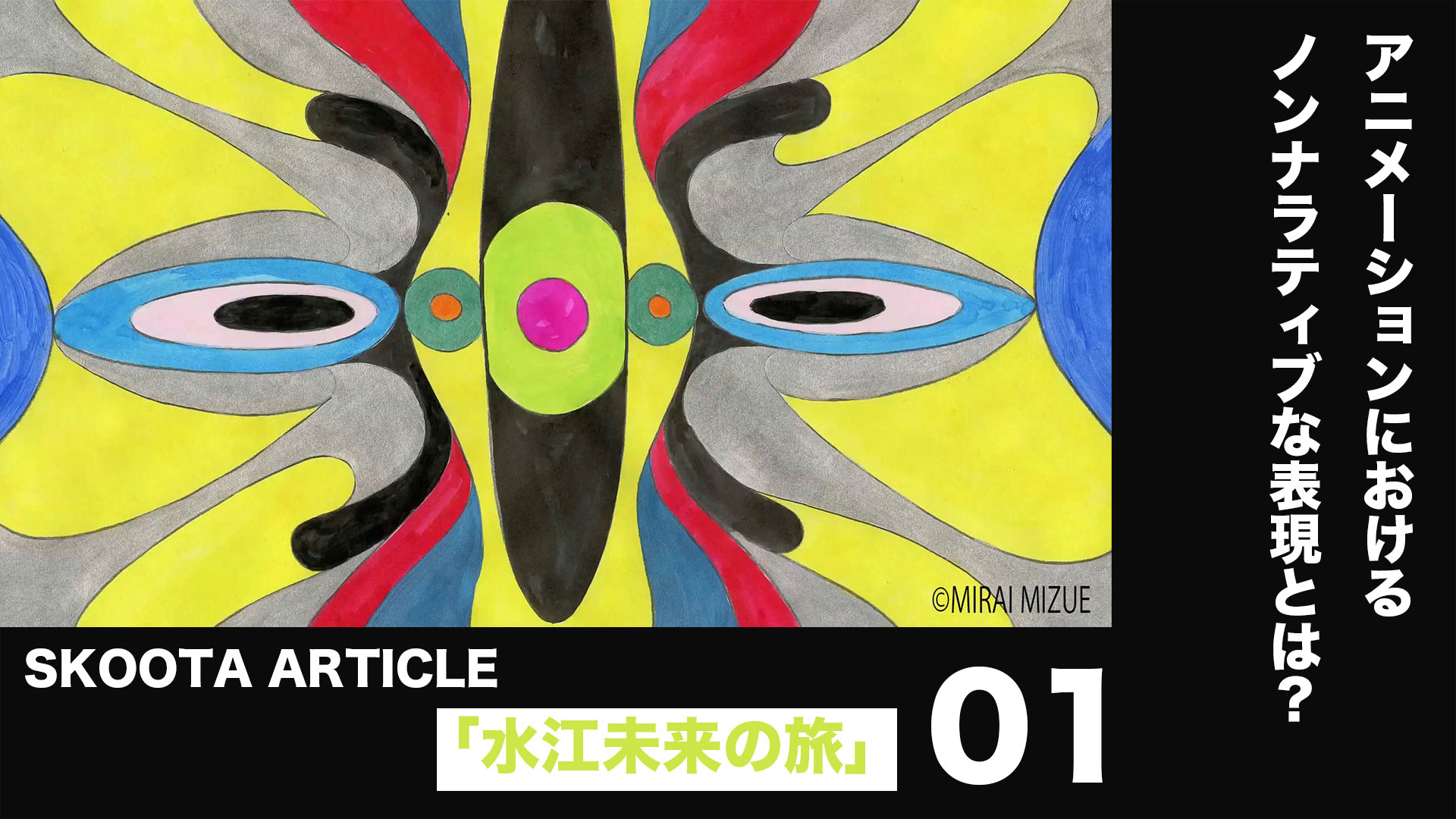
Guest, Personality
Guest: Mirai Mizue
Animation Artist
Born in Fukuoka, Japan in 1981, this animation artist creates non-narrative expressions using motifs such as “cells” and “geometric shapes”. He is known for their unique and captivating abstract animations and have worked on a wide range of projects including independent animation and music videos.
He has been nominated for all four major animation film festivals in the world (Annecy, Ottawa, Hiroshima, and Zagreb), and their masterpiece “MODERN No.2” premiered at the Venice International Film Festival and won the music award at the Annecy International Animation Film Festival.
“WONDER” premiered at the Berlin International Film Festival and won the CANAL+Creative Aid Award at the Annecy International Animation Film Festival. They are currently preparing to produce their first feature-length animation, “Mizue Saiyuki” (tentative title).
Personality: Yuuki Sakoda
After working for a telecommunications company and a comprehensive advertising agency, he started an anime planning and production company and produces music videos and films. In 2021, he moved to Kyoto and started working on promoting the entertainment industry in Kyoto. He is currently also working in the entertainment field of manga and audio. He is planning and producing audio dramas and webtoons. In addition, he serves as a producer and advisor for multiple entertainment companies.
Table of Contents
#01
- What is non-narrative expression in animation?
- My work was screened in the non-narrative section at a film festival.
- It’s not about having no “story” but rather not placing the “story” as the core of the work.
- I continue creating what I like without worrying about genres.
- Falling hurts, and soft things feel comfortable.
- From Jurassic Park and Terminator to the Lumière brothers.
- Movies are not just about stories but also about moments of experience.
- I love the unforgettable experiences scattered throughout films.
- On a summer day, playing a monster movie director game, mimicking an industrial complex in a vinyl pool.
- Memories of watching Return of the Jedi in the theater.
- Growing up with parents who loved movies.
- Standing in line to watch The Phantom Menace as a high school senior.
- A longing for the analog theater space.
- The shock of seeing T-1000.
- A desire to see the strange and unusual.
- From an ETERNITY interview.
- Creating something experimental and bizarre in a short duration.
- A ride-type experience to make a non-narrative piece that won’t let you sleep for 20 minutes.
- Realizing you were in a movie theater when the movie ends.
- The night of a bicycle sprint after watching ET.
#02
- Watching subjective visuals on a large flat screen becomes VR.
- The pleasure of visuals in “Spider-Verse.”
- The value of non-verbal expression.
- The ambiguity when communicating with words.
- Words from a woman in Germany who watched “WONDER.”
- Non-verbal expression may have the power to make viewers think spontaneously.
- Dislike for surveys.
- Talking about “Fraggle Rock.”
- About “Mizue Saiyuki (tentative).”
- The significance of doing Journey to the West now.
- How humans live and perceive the world.
#03
- About “License of Love.”
- Introducing many characters.
- The theme of expanding on life and death.
- Inspired by science books from Gakken that I read as a child.
- About the music by Twoth.
- Twoth also created music for Into Animation 8.
- The program of Into Animation 8.
- Animation is becoming more interesting.
- Anime is starting to cross boundaries, becoming chaotic but exciting.
What is non-narrative expression in animation?
Sakoda
Mirai Mizue is an animation artist born in Fukuoka Prefecture in 1981, who creates non-narrative expressions using motifs such as cells and geometric patterns. He is known for his unique abstract animations that captivate viewers’ eyes and has worked on a wide range of projects such as independent animation and music videos. I am grateful to have the opportunity to speak with such a prominent and shining figure, whom I have been unilaterally observing since a long time ago. First, I would like to read aloud the profile provided by Mizue-san, and then gradually ask about the parts that caught my attention.
While I understand that cells and geometric patterns are the motifs in your work, I have been curious about the frequent use of the term “non-narrative expression.” As a video producer, I have been using the terms “linear” and “narrative” a lot lately. Linear is where the creator presents a single answer, including the development, and the narrative is where the viewer is presented with choices and together we weave the story based on the chosen option. However, in games and other media, narrative is often used to refer to various multiple endings that exist due to the presented choices. I believe that the terms “narrative” and “non-narrative” may have different meanings in the animation industry and film festival categories. Therefore, I would like to hear your interpretation and thoughts on these terms, Mizue-san.
Mirai Mizue
Well, I think the term “non-narrative” is a word that people may not be familiar with. In my work of producing animation, it is sometimes called abstract animation or experimental animation. While there are many experimental and abstract works, when I went to a film festival, there was a category called “non-narrative section” where my work was also screened. It was there that I first came across the term “non-narrative”. It means “no story” when translated literally into Japanese, but when I watched the works being screened, there were various works such as experimental ones, ones with graphic developments, and ones that had a sense of a story. I interpret it as not having the story as the main focus, rather than having no story at all.
I think a story is something where characters appear and drama unfolds, but there are various ways to feel the story. I believe non-narrative contains those. It could also be said to be a story work from a different angle. Although it may have become more complicated by explaining it (laughs).
Sakoda
Yes, I thought it was quite good and interesting that Mizue’s interpretation was put into words. One thing I noticed was that Mizue exhibited his own work at a film festival, and the festival categorized it as “non-narrative” genre. He realized that his work belonged to this genre by seeing the categorization, didn’t he?
Mirai Mizue
Yes, that’s right. I think it was like that. I may not have been aware of it until I applied.
Sakoda
Somehow, drawing lines to define categories or departments is one way of expressing the values defined in society and categorizing things according to those values. In that sense, rather than categorizing something one has expressed oneself, it is quite refreshing to know that there are authorities or perspectives that have categorized things in a certain way, such as through the perspectives of narrative or non-narrative. It seems that Mizue had this experience, and it was quite fresh. There was a kind of academic atmosphere where it seemed like they were already doing it in the non-narrative genre from the beginning!
Mirai Mizue
Yes, that’s right. So, when I first started doing animation, I was making animations of microorganisms moving around or something like that. I didn’t think of it as an experimental or abstract work at the time. I was just making it because I thought it was interesting and fun to watch. So, when someone said, “This is abstract animation,” about the finished product, the first one I made, I was like, “What’s that?”
So, as I continued to work, I gradually learned that there were experimental artists who had been doing this in the past. It wasn’t that my work was becoming this type of work, but rather that I had been doing it in this style from the beginning. I had no idea what my position was at all.
Sakoda
It feels like that, doesn’t it? Instead of trying to fit into a certain genre that exists in the world, I want to create things that I enjoy making without even thinking about fitting in. That’s why I ended up expressing it in a non-narrative, abstract, experimental form.
What I found interesting was that, while watching Ms. Mizue’s work, I thought that this expression might be what is called abstract or experimental in that category, but it actually tells a story. And what’s more? Although I’m a little hesitant to interpret it, I thought that it might be what Mr. Miyazaki wanted to do or something like that.
Mirai Mizue
Um, this is a little bit embarrassing (laughs).
Sakoda
Um, it’s just one perspective (laughs). I mean, of course, stories, modern people tend to be familiar with stories that are formatted into thesis-antithesis-synthesis, but I think stories are quite multi-faceted, from different perspectives, and like a multiverse. I think the feeling of where the story is felt by the viewer is multi-faceted.
So, in a primitive sense, when you fall, it hurts, when you fall on a hard surface, it hurts, when you touch something soft, it feels good, and I think Miyazaki-san portrayed that through animation. Expressing soft things very softly, injuring yourself when you fall on a hard surface, getting injured when falling from a high place, etc. And, when I watch Mizue-san’s animation, I can really feel that things seem very soft or very hard. I personally felt a story from that aspect. So, I think Mizue-san is someone who loves stories, but what do you think about that?
Jurassic Park, the Lumière Brothers, Terminator.
Mirai Mizue
I really love stories. I also love watching movies. Originally, I really liked SF movies and fantasy movies. I didn’t watch much animation. I liked SF movies and I watched movies like “Jurassic Park” and “Terminator 2” in the movie theater when I was in elementary school. I didn’t go to see them by myself, my father took me.
“Terminator 2” was really shocking. I was watching it with a feeling of being pushed back by the persistent pursuit of the T-1000. When the Tyrannosaurus in “Jurassic Park” chased the Jeep, it was a breathtaking experience. Later, I studied film and learned about the Lumiere brothers who invented the film. There is a story about the audience who saw the train arriving at the station and were surprised that the train was coming towards them, and they ran away. I had the same experience when I saw “Jurassic Park” in the movie theater and I was stunned.
So, this movie always provides surprises through its visuals. It’s not just about the story, it’s about the moments that become unforgettable experiences. That’s what movies are about. That’s why I like not only the story, but also the unforgettable experiences that are embedded in movies. I want to incorporate those things into my own work. I think I’m making my works in this style.
Sakoda
Oh, I think that unforgettable experience or moment that I had at the movie theater I was taken to when I was in the lower grades of elementary school is ingrained in Mizue-san as the original experience. Do you still incorporate elements from that moment or instant into what you create now?
Mirai Mizue
Oh, I see. When I think about what forms the basis of the ideas for the things I’m creating, I realize that it’s mostly things I saw when I was a child, in elementary and junior high school, during my teenage years. It feels like it’s already decided based on what I saw back then. As for what I’ve seen since entering university, it feels like I’m following trends a little bit.
Sakoda
Were the movies you mentioned, “Jurassic Park” and “Terminator,” not live-action films? Did you find that you mostly watched live-action films after all?
Mirai Mizue
Um, I used to watch a lot of live-action films. Of course, I went to see “Doraemon” and “Godzilla”. “Godzilla” is a live-action film though. I was often taken to the movies. I saw “My Neighbor Totoro” when I was in first grade of elementary school at the movie theater.
Sakoda
Oh, that was quick. I see, you watched “My Neighbor Totoro” at the movie theater.
Mirai Mizue
I am one of those people who saw “My Neighbor Totoro” in the movie theater and then had to endure the trauma of “Grave of the Fireflies” playing right after. That happened during my childhood, so I belong to that generation.
Sakoda
Wow, that’s amazing. I really want to hear about that experience. Personally, I first saw it on a regular Friday TV show, so I’m curious about what that movie theater experience was like. Could you tell me a little about it?
Mirai Mizue
Okay. We will alternate the screening, you know, at that time.
Sakoda
However, to say that the experience of watching movies in a theater, which was the original experience, is still connected to the present, I don’t think it’s just about watching anime. I think there are many works, including live-action and anime, that have a certain level of storytelling and that have moments of impact or surprise. When I hear that people were watching “Jurassic Park” or “Terminator,” I think it was one of those moments when I started to vaguely think that I wanted to be one of the people making those kinds of works and live like that. Was that the moment when you started to feel that way too?
Mirai Mizue
Well, when I was a child, I used to think about becoming a painter or a designer, but what about a film director? However, when I was in elementary school, I would take out a plastic pool in the garden and play with my younger brother and friends, and then we would start playing monster games. It was like a battle between Ultraman and monsters, where one person became Ultraman and fought the other. Since we had a plastic pool, we would imagine it was a complex like a chemical plant where the battle took place. The monsters would emerge from the seaside. At that moment, I would act like a director and come out to fight, and Ultraman would be in danger at some point. Although I wasn’t actually filming, I was doing some kind of directing and creating scenes, so I think that’s why I became interested in making videos.
Sakoda
So, naturally, you and your friends became actors, turned into Godzilla, and Mizue directed you all. That sounds like a really fun experience! Was this when you were in elementary school, like the lower grades?
Mirai Mizue
Elementary school, I wonder how old that is? Maybe around 4th or 5th grade. That’s about the time.
Sakoda
So, basically, you were taken to a movie theater in chronological order, and they were trying to recreate the excitement of various things you had seen in that vinyl pool and complex, right?
Mirai Mizue
Well, let’s see. I think it was around the same time. It was during the Heisei series of “Godzilla,” so it was around the time when “Godzilla vs. King Ghidorah” and “Godzilla vs. Mothra” were playing. At that time, it was a trend to go see “Godzilla” every New Year’s, so while we were going to see “Godzilla,” “Tora-san” was playing in the movie theater next door or something like that. It was a time when every time we went to see “Godzilla,” there would be a “Tora-san” poster hanging up or something like that. So, while watching “Godzilla,” Hollywood movies like “Jurassic Park” and “Terminator,” which used CG effects, were coming out, and the production values were becoming more and more dynamic, creating a sort of gap between reality and fiction.
Sakoda
The current story is a vivid depiction of the scenery from the Showa to early Heisei era. It’s really interesting how the original experience led to continued involvement in this manufacturing industry. I enjoyed listening to the interesting first half of the story.
Now, I’d like to request to insert a song as we head towards the latter half. I believe during your elementary school days and even in middle and high school, you used to go to the movie theater often. Could you introduce a song that was particularly impressive from a movie or a piece of music you heard during that time?
Mirai Mizue
Yes. Um, I would like to share with you the song “Ewok Celebration and Finale” from “Star Wars: Return of the Jedi,” which was originally titled “Revenge of the Jedi” at the time.
Memory of Watching Return of the Jedi in the Theater
Sakoda
Yes, what you heard is “Ewok Celebration and Finale” from “Star Wars: Return of the Jedi.” But, Mizue, I think there are also many significant episodes in this song.
Mirai Mizue
Yes. Well, you see, “Return of the Jedi” was originally titled “Revenge of the Jedi” before it was released in Japan. The movie was released in 1983 and since I was born in 1981, I was only two years old at the time. However, my parents went to see the movie in theaters carrying me with them. But since I cried in the theater, my father went in to watch the movie first while my mother waited outside holding me. When my father finished watching, we switched places and my mother went in to watch the next showing. I later heard from my parents that this is how I watched the movie, although I didn’t actually go into the theater myself.
Anyway, my parents were huge “Star Wars” fans, as you can understand from the current episodes. We had a VHS tape at home that was probably copied from a laser disc or something because chapter markings appeared in the middle of the movie. The Japanese subtitles were from the first release, so “The Force” was written as “Riryoku” (a combination of “ri” meaning “science” and “ryoku” meaning “power”), and “lightsaber” was written as “Denkoken” (a combination of “denki” meaning “electricity” and “ken” meaning “sword”). I watched that VHS tape countless times during my childhood, so I became a huge “Star Wars” fan.
However, the movie was released before I was born or shortly after, so it was about 10 to 17 years later when a new “Star Wars” movie was announced. It was “Episode I: The Phantom Menace.” I was a third-year high school student at the time and I couldn’t believe that I would be able to watch “Star Wars” again. I went to see it at the Nippon Theater in Yurakucho, which is the largest movie theater in Japan. I went with my friends from art school and we lined up from around 10 p.m. the night before. About 400 people were already lining up at that time, and I think the theater could hold about 2,000 people.
We lined up all night and watched the first screening the next morning. It was really exciting to watch the movie in the theater with so many cosplayers and festive atmosphere. However, I started to feel like something was a little different from what I had expected. Nevertheless, I was still excited to be able to watch “Star Wars” after such a long time. When the end credits music started, I was still excited and I went to see the movie about five more times, alone in the theater.
The really interesting thing about “Star Wars” is that I love the moment when the end credits start to roll, especially in Episode VI, which is the last piece. It’s when the battle against the Empire is over and everyone is celebrating and the finale starts. It’s a really uplifting moment for me and I love that music.
Sakoda
I mean, in the first half, there was talk about how SF and fantasy are often seen, and there is a source there, right? In some way, in Mizue’s film works, there is a sense of SF, like a motif. Somehow, in the moment of joy, that final moment, it’s like there’s a turn of reward for those who watched, like in “One Piece” where everyone cheers after defeating evil. There’s a feeling of that kind of emotional impact in Mizue’s works. I don’t know if she’s conscious of it as the creator, but I feel like it’s connected to that.
This might be a sudden change of topic, but Mizue has been nominated for all four of the world’s major animation film festivals – Annecy, Ottawa, Hiroshima, and Zagreb. One of her representative works, “MODERN No 2,” premiered at the Venice International Film Festival and won the music award at the Annecy International Animation Film Festival. From childhood to now, she has been active in physical places like movie theaters and film festivals, even though she creates her works digitally. I thought that she has a strong admiration for analog things, but I wanted to hear various opinions about how Ms. Mizue feels about the current digital situation and the analog space of movie theaters.
Mirai Mizue
Well, as for techniques, I’m not really an analog enthusiast. Even with CG, I think the T-1000 in “Terminator 2” was really exciting. That liquid metal, that T-1000…
Sakoda
Ah, yes, that expression.
Mirai Mizue
Yeah, that’s right. I mean, I really wanted to see the scene where the T-1000 appears and shows its metal flexibility. So, the reason why I first became interested in analog animation was because it gave me a very unique feeling. It’s the same with sci-fi movies from the 90s, where CG effects were starting to become more prominent and I was drawn to the slightly unusual expressions that came with it. I think I probably felt the same way when I first saw “Toy Story”. It was kind of weird animation. Basically, I was used to watching 2D animation, so when it came to a feature-length animation in 3DCG, there was something a little strange about it.
So, nowadays, the use of 3DCG is becoming so realistic that it’s hard to tell where CG is being used, and the sense of strangeness that comes with it is becoming less noticeable. However, in the midst of all this, I think there are still a lot of short analog animations, like stop-motion animation, which are still able to give you that sense of strangeness. When I saw these things in “Star Wars”, I was like, “What is this?” and it really piqued my interest. So, the reason I started making things was just because of these short analog animations. It’s not that I don’t like CG or anything like that. I love anything that’s just plain strange, including CG.
Sakoda
Hmm, I see. I think “Toy Story” was probably the first one in 1995 that was interesting. I assume Mizue saw it in the theater. But during that time, things like using CG to create something was one of the selling points of a movie, like in “Terminator”. Especially with “Toy Story”, the challenge of making animation with CG was a situation that also led to investment. So I think Mizue was more drawn to the strange and peculiar feeling that emerged when something that was made analog was made with CG, rather than the story itself.
And so, I watched the YouTube interview where he talked about “ETERNITY”, and there was quite a bit of talk about the technical aspects, like being a touch designer and using Unity. So I feel like he’s always pursuing the peculiarity of using various tools of the time. “Different” and “strange” might be the keywords, I guess.
Mirai Mizue
Well, let’s see. I guess I just want to see strange things, you know? Seeing strange things gives me a kind of happiness, like a sense of fulfillment. It’s like the happiness you get from watching a movie. It’s kind of like pleasure, but not exactly.
Sakoda
However, it may be possible that there are societies that only have one value system, where they believe that something uniform is great, although the key is diversity. It is definitely true that a diverse society that tolerates even strange things has a lot of richness, with various strange forms being allowed. I thought that there might be a lot of talk about that.
There is a movement that has continued to pursue various strangeness experimentally, which has remained since ancient times, especially in short stories. I thought that it might be related to the non-narrative, experimental story that was mentioned earlier. In a short length, there is a place where you can experimentally create animations that are strange, very memorable, and lead to pleasure, borrowing Mizue’s words.
Well, there are some things I would like to ask after seeing Mizue’s work, and I don’t know if you are interested, but I thought about whether there are quantum mechanical things or Buddhist motifs. One thing that was mentioned in the interview of “ETERNITY” was the potential of abstract animation that the spirit is freed from the body and it is more facilitated when viewed in long things (long videos). I was really interested in this word, so I wanted to ask about it in more detail here.
A ride-based creative approach was used to create a non-narrative piece that keeps the audience awake for 20 minutes.
Mirai Mizue
Hmm, let me see. The work called “ETERNITY” is 21 minutes long. Most of the animations I have made so far are around 3 to 6 minutes long, so with those, you can develop the story according to the structure of one song, where the excitement of one song builds up and reaches its climax. But when it comes to 20 minutes, you have to think about the structure of the music as well.
Abstract animations that are 20 minutes long are not unheard of. When you go to film festivals and see experimental programs, there are works that are about 20 minutes long and it feels like they just keep flashing. They make you feel comfortable and you gradually fall asleep, but still, I wanted to create something that wouldn’t let you sleep for 20 minutes, something non-narrative. And also, I wanted to create something like a ride, where you feel like you’re moving on something visually. So, for the work “ETERNITY”, I thought about moving through a tunnel, or through a groove, or taking a camera through a sphere like a mandala.
In my previous works, there were many motifs that appeared on the screen, creating a cluttered feel. However, this time, there are many things overflowing in the space, as if the camera is pushing forward into it. I wanted to create something where even though I am sitting in a cinema seat, I feel like I am constantly moving forward, exploring different places.
The feeling of detachment is probably something that happens when watching any movie. When the end credits roll, you realize that you were just sitting in a cinema seat the whole time and you think, “Okay, time to go.” It’s like your mind is completely immersed in the movie, but your body or your feelings are detached from it.
Sakoda
A movie that pulls you in like that, if it turns out to be a hero movie when you step outside after watching it, you might feel a little stronger.
Mirai Mizue
Well, let me see. Yeah, I remember feeling like that when I was in high school and went to the movie theater. I just recalled that feeling now. Recently, when I watch movies as an adult, I tend to get caught up in all the convoluted logic and end up not really focusing on the movie.
Sakoda
In the past, after watching hero movies, I used to get so immersed that I would fall into the fantasy of being able to win even if someone tried to pick a fight with me. Thinking back on those days makes me feel a little nostalgic and sad, haha.
Mirai Mizue
You know, right? When I was in college, the director’s cut version of “E.T.” was shown in theaters. I rode my bike for about 20 minutes to see it and on the way back, I really rode my bike at full speed. ET flies on a bike, you know. I remember riding my bike back home at night, screaming “woohoo!”.

